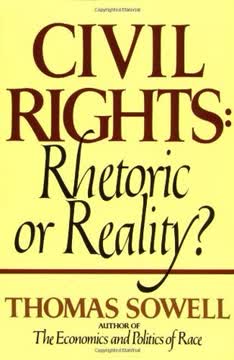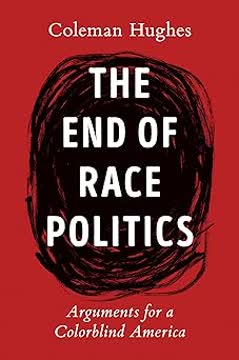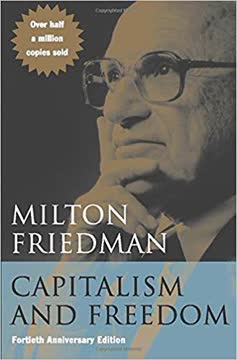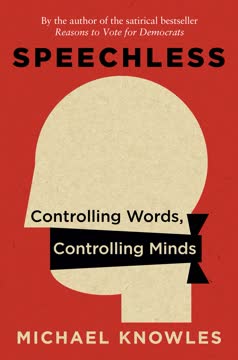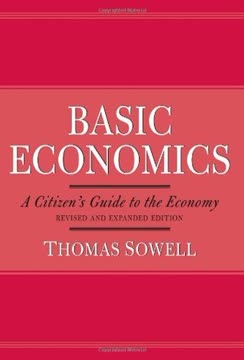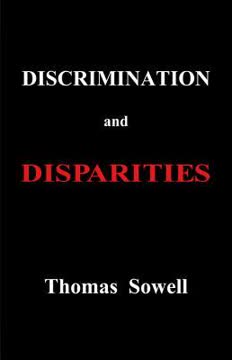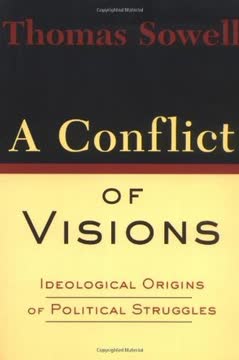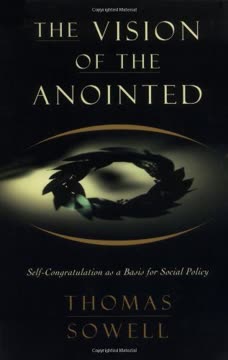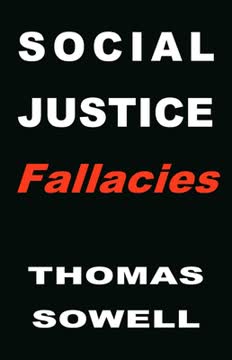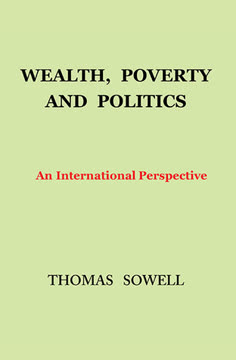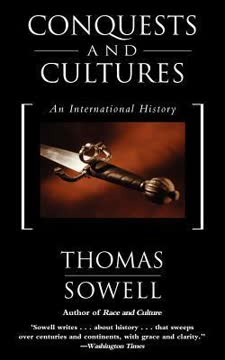Key Takeaways
1. The Civil Rights Vision: A Flawed Cause-and-Effect Theory
The civil rights vision is not only a moral vision of the way the world should be in the future, but also a cause-and-effect vision of the way the world is today.
Vision's core premise. The civil rights vision, born from the fight against blatant discrimination, posits that statistical disparities between groups in income, education, and occupation are primarily caused by societal discrimination. Rejecting innate inferiority as an explanation, this vision concludes that unequal results must stem from unequal treatment by "society."
Implicit assumptions questioned. This cause-and-effect theory rests on unspoken assumptions: that discrimination leads to adverse statistical effects, and conversely, that large statistical differences imply discrimination. The vision assumes a random distribution of outcomes in the absence of discrimination, ignoring numerous other factors that cause group differences.
Alternative explanations exist. Many non-discriminatory factors lead to vast statistical disparities, such as:
- Age differences between groups
- Geographic concentration
- Cultural values and choices (e.g., marriage age, field of study)
- Historical migration patterns
These factors, often ignored by the vision, profoundly impact group outcomes.
2. The Shift from Equal Opportunity to Group Results
Many Americans who supported the initial thrust of civil rights... later felt betrayed as the original concept of equal individual opportunity evolved toward the concept of equal group results.
From individual rights to group outcomes. Initially, civil rights meant equal treatment under the law for individuals, regardless of group membership. However, the civil rights vision's premise that disparities imply discrimination led to a shift towards demanding equal group results, often through preferential treatment.
Affirmative action's transformation. The term "affirmative action" initially meant ensuring equal opportunity (e.g., outreach). By the early 1970s, it was redefined by administrative agencies and courts to mean achieving statistical "representation" or "utilization" of minorities and women, effectively becoming a numerical concept ("goals and timetables").
Ignoring legislative intent. This transformation occurred despite the clear intent of the Civil Rights Act of 1964, which explicitly stated it did not require employers to grant preferential treatment to achieve racial balance. Administrative agencies and courts prioritized the "spirit" of the Act (addressing black economic problems) over its literal words and legislative history.
3. Busing: A Tangled Web Based on Unproven Assumptions
The central assumption behind busing was perhaps nowhere better expressed than by Los Angeles Judge Paul V. Egly, when he declared that minority students would be “irreparably damaged” if busing were even delayed, and that his task was to “make the most efficient use of increasingly scarce white students as possible” by spreading them around for the benefit of the many minority youngsters who constituted a majority of that city’s school children.
"Separate is unequal" rationale. The Brown v. Board of Education decision, while politically masterful, based its core legal rationale on the psychological theory that separating children by race inherently creates feelings of inferiority, thus making separate schools unequal. This theory, attributed to "modern authority," became the basis for demanding racial mixing.
Evolution to mandatory mixing. Initially, Brown called for desegregation "with all deliberate speed." However, the underlying psychological doctrine led courts to demand racial balance as proof of desegregation, culminating in mandatory busing orders even in districts with no history of de jure segregation.
Assumptions vs. evidence. The assumption that racial mixing is necessary for educational equality or self-esteem is not supported by evidence.
- Studies show mixed results on self-esteem in integrated settings.
- Historical data show high performance in ethnically segregated schools (e.g., Jewish, Chinese, German schools).
- Large educational disparities exist between groups even within the same integrated schools.
The busing mandate stemmed from a vision and unproven theory, not empirical reality.
4. The Special Case of Blacks: Culture, Not Just Color, Explains Outcomes
Blacks may “all look alike” to racists, but there are profound internal cultural differences among blacks.
Beyond unique history. While blacks have a uniquely oppressive history in the U.S., this does not fully explain contemporary outcomes. Other groups, both in the U.S. and internationally, have faced severe discrimination yet achieved higher economic status than blacks, or even the dominant group.
Internal group differences matter. Significant economic differences exist within the black population based on cultural factors.
- West Indian blacks in the U.S. have significantly higher incomes and professional representation than other blacks, even second-generation West Indians born in the U.S.
- Black husband-wife families, particularly young, college-educated ones, have achieved income parity or surpassed white counterparts.
These differences persist despite all groups being subject to the same racial discrimination.
Cultural factors' impact. Home environment, family structure, educational choices (e.g., math/science vs. education degrees), and work habits significantly impact economic outcomes, often more than racial discrimination. These cultural differences exist within the black community and between blacks and other groups.
5. The Special Case of Women: Economic Realities Beyond Discrimination
The big difference is not between men and women, but between married women and everyone else.
Debunking the "59 percent" cliché. The widely cited statistic that women earn 59% of men's income is misleading. It compares all women to all men, ignoring crucial differences in hours worked, continuous years of experience, and occupational choices.
Marriage and motherhood's impact. The primary factor explaining the overall income gap is the economic consequence of marriage and motherhood.
- Single women working full-time earn significantly closer to single men (around 91%).
- Married women work fewer hours and have more career interruptions than married men.
- Marriage often increases a man's earning potential while decreasing a woman's options due to domestic responsibilities.
Occupational choices and history. Women historically gravitate towards occupations with slower skill obsolescence, allowing for career interruptions. Historical data show women's representation in high-level fields fluctuating with birth rates, not just political or legal changes. Black women, with a history of higher labor force participation, achieved income parity with white women decades ago.
6. Politics: Earmarked Benefits vs. Concealed Losses
Politically, however, it makes far more sense for a black leader to fight tooth and nail for a hundred more CETA jobs in the Philadelphia ghetto than to fight for an end to taxi licensing restrictions, even though the latter would probably mean thousands more jobs for blacks—jobs with far higher pay than CETA jobs and of permanent duration.
Political incentives shape agenda. Black politicians and civil rights leaders are incentivized to pursue "earmarked benefits" for their constituency – programs explicitly labeled for blacks or minorities. These provide visible political gains, even if small or temporary.
Ignoring concealed losses. Policies that harm blacks as members of the general public, but are not explicitly racial, are often ignored or even supported if they benefit political allies (e.g., labor unions supporting minimum wage laws that harm black teenagers).
- Minimum wage laws increase black teenage unemployment.
- Occupational licensing laws restrict entry into well-paying fields (e.g., taxi drivers).
- Unionization and regulation have historically pushed blacks out of certain industries (e.g., railroads, trucking).
Net effect on the disadvantaged. The focus on earmarked benefits, often achieved through political logrolling, can result in substantial "concealed losses" that disproportionately harm the most disadvantaged blacks, who may not benefit from the earmarked programs at all. Affirmative action, an earmarked benefit, primarily helps already advantaged minorities while potentially harming the less qualified.
7. Rhetoric vs. Reality: Economics, Standards, and Marketplace Signals
From an economic point of view, to say that any group is systematically underpaid or systematically denied as much credit as they deserve is the same as saying that an opportunity for unusually high profit exists for anyone who will hire them or lend to them.
Marketplace corrects inefficiencies. In a competitive economy, systematic discrimination that results in underpaying or underutilizing a group represents a profit opportunity for competitors. Businesses that hire these undervalued workers gain a cost advantage, pressuring discriminatory firms to change or fail.
Standards are economically rational. Employers use standards and qualifications not out of bias, but because they matter economically. Even for seemingly "unskilled" jobs, reliability, punctuality, and attitude impact productivity and profit. Disparities in these traits, not just technical skills, affect hiring and performance outcomes.
Reality beyond perceptions. Economic realities, like supply and demand or differences in group characteristics and choices, are transmitted through the marketplace regardless of "perceptions" or "stereotypes." The success of institutions like the Bank of America, founded by Italian immigrants to serve their community, demonstrates how marketplace realities can override biases.
8. The Degeneration of Racial Controversy: Evidence is Ignored
Not since the days of Senator Joe McCarthy has the drive to discredit so overridden every other consideration.
New McCarthyism. The debate on race has become poisoned by a disregard for truth, characterized by ad hominem attacks, misrepresentation of arguments, and the creation of straw men to discredit critics of the prevailing civil rights vision.
Ignoring inconvenient facts. Evidence that contradicts the vision (e.g., black economic progress before civil rights laws, internal black differences, women's economic progress tied to demographics) is often ignored, suppressed, or dismissed with ad hoc explanations lacking empirical support.
Vision over evidence. For many proponents, the civil rights vision is a substitute for evidence. Conclusions are accepted because they logically follow from the vision, not because they are supported by facts. This leads to blaming "society" or "racism" even when other factors provide clearer explanations.
Consequences of the climate. This climate of intolerance hinders rational discussion, prevents understanding the true causes of disparities, and risks alienating potential allies, ultimately harming the very groups the civil rights vision claims to champion.
Last updated:
FAQ
What’s "Civil Rights: Rhetoric or Reality?" by Thomas Sowell about?
- Critical examination of civil rights: The book analyzes the evolution of civil rights in the United States, questioning whether the outcomes have matched the original intentions.
- Rhetoric vs. reality: Sowell contrasts the ideals and promises of the civil rights movement with the actual results, especially regarding policies like affirmative action and busing.
- Focus on group outcomes: The book scrutinizes the shift from equal opportunity to equal results, and the implications of this shift for various groups, including blacks, women, and other minorities.
- Empirical approach: Sowell uses historical data, economic analysis, and international comparisons to challenge prevailing assumptions about discrimination and group disparities.
Why should I read "Civil Rights: Rhetoric or Reality?" by Thomas Sowell?
- Challenging conventional wisdom: The book offers a contrarian perspective on civil rights policies, questioning widely accepted narratives about discrimination and progress.
- Data-driven arguments: Sowell supports his claims with empirical evidence, making it valuable for readers interested in fact-based policy analysis.
- Broader implications: The book discusses not just race, but also gender and international cases, making its lessons relevant beyond the U.S. context.
- Understanding policy consequences: Readers gain insight into the unintended effects of well-intentioned policies, helping inform debates on social justice and equality.
What are the key takeaways from "Civil Rights: Rhetoric or Reality?" by Thomas Sowell?
- Equal opportunity vs. equal results: Sowell argues that the original civil rights vision focused on equal treatment, but later policies shifted toward enforcing equal group outcomes.
- Statistical disparities are not proof: The book contends that differences in group outcomes are not necessarily evidence of discrimination, as many other factors are at play.
- Affirmative action’s mixed results: Sowell claims that affirmative action often benefits already-advantaged minorities while harming the most disadvantaged.
- Cultural and demographic factors matter: The author emphasizes the importance of cultural, demographic, and behavioral differences in explaining group disparities.
How does Thomas Sowell define the "civil rights vision" in "Civil Rights: Rhetoric or Reality?"?
- Moral and causal vision: The civil rights vision is both a moral ideal (how society should be) and a causal theory (why disparities exist).
- Assumptions about disparities: It assumes that statistical differences in income, education, or employment are caused by discrimination or societal bias.
- Political solutions emphasized: The vision prioritizes political action and legal remedies as the primary means to address group disadvantages.
- Neglect of alternative explanations: Sowell argues that this vision often ignores cultural, demographic, and economic factors that also influence group outcomes.
What is Thomas Sowell’s critique of affirmative action in "Civil Rights: Rhetoric or Reality?"?
- Shift from opportunity to quotas: Sowell criticizes the move from equal opportunity to group-based preferences and quotas, arguing it undermines merit.
- Benefits the already advantaged: He presents evidence that affirmative action often helps minorities who are already better off, rather than the most disadvantaged.
- Negative impact on the disadvantaged: The policy can make it harder for less-qualified individuals within preferred groups to find jobs, as employers become more cautious.
- Lack of empirical support: Sowell claims there is little evidence that affirmative action has accelerated economic progress for minorities compared to pre-existing trends.
How does "Civil Rights: Rhetoric or Reality?" address the issue of statistical disparities and discrimination?
- Disparities not always discrimination: Sowell argues that group differences in outcomes can result from many factors besides discrimination, such as age, education, and culture.
- Examples from other groups: He cites cases where minorities facing discrimination (e.g., Chinese in Southeast Asia, Jews in Europe) have outperformed majorities economically.
- Statistical pitfalls: The book warns against using broad statistical categories to infer discrimination, as aggregation can obscure important differences.
- Variance and randomness: Sowell explains that even in a world without discrimination, random variance would still produce group disparities.
What does Thomas Sowell say about the effectiveness of busing and school desegregation in "Civil Rights: Rhetoric or Reality?"?
- Assumptions questioned: Sowell challenges the assumption that racially mixed schools inherently produce better educational outcomes for minorities.
- Historical evidence: He presents data showing that some all-minority schools have performed as well or better than integrated schools, and that group disparities persist even within the same schools.
- Unintended consequences: The book argues that busing and forced integration have often led to social conflict and "white flight," without clear educational benefits.
- Focus on opportunity: Sowell suggests that opening access to schools is more important than engineering specific racial balances.
How does "Civil Rights: Rhetoric or Reality?" treat the "special case" of blacks in America?
- Unique history acknowledged: Sowell recognizes the distinct history of slavery and Jim Crow affecting black Americans.
- Not uniquely disadvantaged: He argues that, despite this history, blacks are not always the most disadvantaged group in terms of income, education, or family structure.
- Role of culture and migration: The book highlights the economic success of culturally distinct black groups (e.g., West Indians) and the importance of migration and education in black advancement.
- Policy implications: Sowell contends that policies based solely on race may miss the real drivers of progress or pathology within the black community.
What arguments does Thomas Sowell make about women and gender disparities in "Civil Rights: Rhetoric or Reality?"?
- Misinterpretation of statistics: Sowell critiques the common claim that women earn only 59% of what men earn, pointing out differences in hours worked, career interruptions, and occupational choices.
- Marriage and motherhood effects: He explains that marriage and motherhood have opposite effects on men’s and women’s earnings, which is often ignored in policy debates.
- Historical trends: The book notes that women’s representation in high-level positions has fluctuated with demographic trends, not just legal or political changes.
- Skepticism of "comparable worth": Sowell questions the logic and practicality of policies that attempt to equalize pay for different jobs deemed of "comparable worth."
How does "Civil Rights: Rhetoric or Reality?" address the international context of group preferences and quotas?
- Global comparisons: Sowell examines affirmative action and group preferences in countries like Malaysia, India, and Uganda, finding similar patterns and problems.
- Limited effectiveness: He argues that such policies have not closed economic gaps between groups, even when administered by the majority group in power.
- Political incentives: The book suggests that preferences often benefit politically connected or already-advantaged members of the preferred group.
- Polarization risk: Sowell warns that group preferences can increase social polarization and resentment, both in the U.S. and abroad.
What are the main criticisms Thomas Sowell has of the current civil rights discourse in "Civil Rights: Rhetoric or Reality?"?
- Rhetoric over substance: Sowell contends that civil rights language has been co-opted to justify group preferences and special interests, rather than genuine equal rights.
- Suppression of evidence: He criticizes the tendency to dismiss or ignore empirical evidence that contradicts the prevailing civil rights vision.
- Straw man arguments: The book documents how critics of affirmative action and group preferences are often misrepresented or attacked personally.
- Long-term dangers: Sowell warns that the misuse of civil rights rhetoric can erode trust in law, fuel resentment, and threaten social cohesion.
What are the best quotes from "Civil Rights: Rhetoric or Reality?" by Thomas Sowell and what do they mean?
- "Equal treatment does not mean equal results. Everything desirable is not a civil right."
- Sowell emphasizes the distinction between fair process and guaranteed outcomes, warning against expanding civil rights to cover all social goals.
- "The right to vote is a civil right. The right to win is not."
- This quote highlights the difference between access and entitlement, critiquing policies that seek to engineer outcomes rather than ensure fairness.
- "The battle for civil rights was fought and won—at great cost—many years ago."
- Sowell argues that the fundamental legal barriers have been removed, and that current issues are more about social and economic factors than legal discrimination.
- "Sincerity of purpose is not the same as honesty of procedure. Too often they are opposites."
- He cautions that good intentions do not justify dishonest or manipulative policy-making, especially when it undermines trust and fairness.
Review Summary
Civil Rights: Rhetoric or Reality is a thought-provoking book that challenges common perceptions about civil rights and affirmative action. Readers praise Sowell's analysis of statistics and his arguments against certain civil rights policies. Many find the book still relevant today, though some criticize his approach as lacking sociological context. Sowell's writing style is described as blunt but driven by concern for the disadvantaged. The book encourages readers to question assumptions and examine evidence carefully when considering civil rights issues.
Similar Books
Download PDF
Download EPUB
.epub digital book format is ideal for reading ebooks on phones, tablets, and e-readers.
